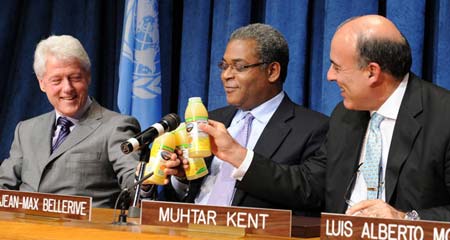
July 2010
No Housing, No Jobs – Bonanza for NGOs, Sweatshops and Agribusinesses
Capitalist “Reconstruction” of Haiti 
MINUSTAH
soldier
stands guard as residents of tent city inspect “relocation”
site, Corail Cesselesse,
where they were moved on April 10. No housing, no water, no food, no
sanitation facilities, no jobs,
no transportation. (Photo: Liz O. Baylen/Los Angeles Times)
After
all the televised hype about “Hope for Haiti,” the post-earthquake
reality
remains grim. Little aid is reaching survivors, almost no housing has
been
built, the “temporary” camps are breeding disease and liable to be
swept away
by the next storm, residents are facing eviction with nowhere to go,
and the
police and mercenary occupation troops are back to their usual practice
of arbitrary
arrests and raids on poor districts. All this is the result not of a
natural
event, but of the chaos and oppression inherent in capitalism. This is
the continuing
devastation of New Orleans’ Lower Ninth
Ward (almost five years after Hurricane Katrina) to the nth degree,
compounded
by semi-colonial dependence. If NOLA
residents
got the 82nd Airborne and toxic trailers for housing, Port-au-Prince
got the
82nd Airborne plus U.N. “peacekeepers” ... and no housing. Not even
one-fifth
of “tent camp” residents have received tents, most are still living
exposed to
the elements under tarps and make-shift shelters.
First
there are the looters. No, not the non-existent roving bands of youths
stealing
food from babies that the U.S. military was supposedly sent in to
control, but
some of the aid agencies themselves. Most suspect is the American Red
Cross
(ARC), notorious in the “aid community” for its bloated bureaucracy and
diverting funds. The ARC raised $430 million for Haiti, partly through
appeals
by First Lady Michelle Obama. People in Haiti are asking “where did
that money
go?” – particularly since nobody has seen any of it on the ground. The
ARC
refuses to make its records public, but said it had spent “or
allocated” $106
million in the first two months, mainly by giving it to the U.N.’s
World Food
Program and international Red Cross efforts. But an ARC official argues
that
spending lots of money in an emergency when “everything is expensive”
is “not
being efficient.” The ARC is holding back the rest to be used for
things like
“water sanitation systems” – plus, of course, the 9 percent it charges
for administration
(Miami Herald, 27 April). A bitter
Haitian joke says that if a local politician takes a rake-off, it’s
corruption,
but if an NGO takes the same cut, it’s called “overhead.”
Then
there is shelter. Initially, the Haitian government vowed it would
provide
housing for earthquake victims on safer ground. However, when 2,000
residents
were bused to the first site, Corail Cesselesse, they found a barren
dust-blown
plain far from the city without electricity, water supply, latrines,
jobs,
transportation, a place to buy food or anything at all. When President
Préval
showed up for a photo op, people complained they were being dumped in a
“wasteland.”
The bureaucrats’ talk of “decentralizing” Haiti was nothing but
forcibly depopulating
the capital – finishing the job for the earthquake. “Although there is
open
land closer to the city, landowners have not been willing to give it
up,”
reported the Los Angeles Times (18
April). A month and a half later, even the World Vision aid agency
complains
that the flimsy tents provided at Corail are inadequate for storms: “no
tent or
tarp is able to withstand that type of weather.” A spokesman for Oxfam
asks:
“Why did we pick a flood plain in the middle of the desert for this
site?”
(“Many Say Haiti Unprepared for Hurricane Season,” Miami
Herald, 31 May).
In
contrast to the perilous situation at the Corail site, the Herald
writes, “Petionville Golf Club is a model of what can be
done.” Disaster experts point out the sandbagging, ditches and fence
around a
ravine, adding that 4,000 people living in the most “at-risk” part of
the Golf
Club were relocated. Two things the article didn’t mention are: that
the
at-risk residents were relocated to the hellhole of Corail, and the
manager of
the Pétionville camp in the lush hills above Port-au-Prince is
actor Sean Penn.
Every visiting statesman passes through the Pétionville camp,
and with USAID,
Catholic Relief Services and the Israeli government pumping in
resources, there
are a few more facilities. Right across the street are boutique shops
and posh
restaurants catering to prosperous Haitians from the nearby gated
mansions, as
well as a casino and brassy nightclub for foreign aid workers. “The
thumping
beat of capitalism can be heard by those now living on
Pétionville’s streets,”
reported the New York Times (28
March). So things go better with money – lots of it – but whether any
will
trickle down is another matter.
As
for temporary shelters, barely 2,000 have been built. (Although no more
than
glorified wooden boxes, they do offer some protection from extreme
weather.)
The American Red Cross said it had spent $30 million on materials for
such
“T-shelters,” but they are sitting in storage. The Canadian Red Cross
was about
to start building T-shelters, but they stopped. Why? In both cases
because the
Haitian government could not find land with clear property title to
place them
on. Meanwhile, some landowners, particularly several church-owned
schools, have
been creating obstacles to access, blocking food deliveries, destroying
latrines,
cutting off water, even threatening to use tear gas – doing everything
possible
to push camps off of their property. The Haitian government and the
U.N. agreed
on a temporary moratorium on forced evictions, but the minister in
charge
hasn’t informed anyone, and the ban is not being enforced (“As
‘Temporary’
Camps Linger, Tensions Rise with Haitian Landowners,” IPS, 9 June).
 Bill
Clinton, the new neo-colonial gouverneur
of Haiti, with Prime Minister Jean-Max Bellerive (center) and Muhtar
Kent, chairman of Coca-Cola, launch new mango beverage at imperialist
donors’ conference on Haiti, March 31.
Bill
Clinton, the new neo-colonial gouverneur
of Haiti, with Prime Minister Jean-Max Bellerive (center) and Muhtar
Kent, chairman of Coca-Cola, launch new mango beverage at imperialist
donors’ conference on Haiti, March 31.
(Photo: The Coca-Cola Company)
This
brings us to the role of the “multinational” (mainly U.S.)
corporations,
waiting to cash in on the reconstruction. A liaison to Clinton’s HIRC
told a
Haitian entrepreneur that only 15 percent of the aid contracts would go
to
Haitian contractors (Haiti-Liberté,
16 June). U.S. debris-removal companies (Ashbrit, Ceres) are lining up
at the
trough, and giant construction firms like Halliburton, Bechtel, Fluor
and Brown
& Root are eager for action as their Iraq contracts wind up. In the
countryside,
the agrochemical giant Monsanto figured it would get in ahead of the
competition
by donating 475 tons of hybrid seeds. Peasant organizations held a
protest
march in Hinche that burned some of the seeds, saying they would make
small
growers with limited cash income dependent on annual purchases from
Monsanto
(producer of Agent Orange and other herbicides used in
counterinsurgency
warfare) and would lead to the destruction of peasant agriculture. In
turn,
Coca-Cola (with the endorsement of Bill Clinton) has launched a $7.5
billion
“Haiti Hope Project” to produce mangos for a new mango-lime beverage,
claiming
this would provide 25,000 jobs for Haitian mango farmers. As with
Monsanto’s
“donation,” those likely to benefit are agribusinesses, not peasants.
However,
the main focus for capitalist reconstruction schemes is on expanding
Haiti’s
role as a provider of low-wage sweatshop labor. The garment industry,
Haiti’s
largest employer and source of export revenue, was relatively unscathed
by the
earthquake: of 28 plants, 23 suffered minor damage and for most,
production
resumed within weeks. However, the Palm Apparel factory in Carrefour,
near the
epicenter of the quake, collapsed, killing some 500 workers doing
overtime to
fulfill their piecework quotas. Garment workers are almost entirely
non-unionized, with most earning no more than the minimum wage of 125
gourdes
(US$3) a day. The HOPE I and II acts passed by the U.S. Congress in
2006 and
2008 allow duty-free apparel imports from Haiti, and George Soros is
building a
new industrial park near the impoverished slum of Cité Soleil in
Port-au-Prince
to take advantage of this. But aside from the absurdity of pretending
that
$3-a-day jobs are a road out of poverty, the reality is that the
garment industry
in the Caribbean and Central America is rapidly declining
as U.S. companies prefer even lower-wage Asian producers
(see David Wilson, “‘Rebuilding Haiti’ – the Sweatshop Hoax,” MRzine, 4 March).
In
short, the plans for capitalist reconstruction of Haiti may be
money-makers for
U.S. multinationals, but they are a dead-end for Haitian workers,
peasants and
the poor. And the pipe dreams of the “anti-globalization” movement and
various
“progressive” Haitian NGOs such as the Platform to Advocate Alternative
Development Policies (PAPDA) – of a new “development model” based on
“participatory democracy,” “an end to economic dependency” and an end
to
“neo-liberalism” – will go up in smoke because the real obstacle is not
a
particular policy but the workings of the capitalist system. The
reality is, as
Bruno Lemarquis, Haiti director of the U.N. Development Program,
pointed out:
“The same rain that is killing 200 people in Haiti is not killing
anybody in
Cuba. It’s not the disaster that kills. It’s the way a country or its
people
are prepared.” And Cuba is prepared with an elaborate system of
shelters, plans
for mobilization and free medical facilities because it
had a social revolution. The League for the Fourth
International insists that nothing short of that can rescue Haiti from
the
cycle of poverty and destruction, and in this imperialist epoch that
must be a
socialist revolution reaching into the heart of the empire. ■
See also: Haiti Earthquake: Capitalism, Occupation and Revolution
To contact the Internationalist Group and the League for the Fourth International, send e-mail to: internationalistgroup@msn.com